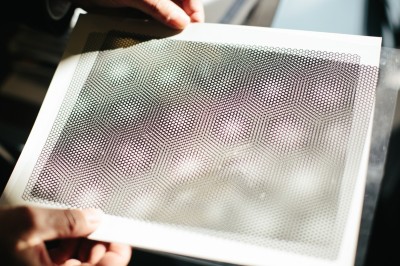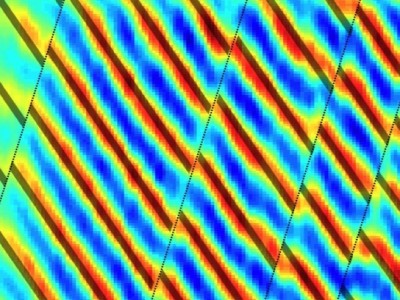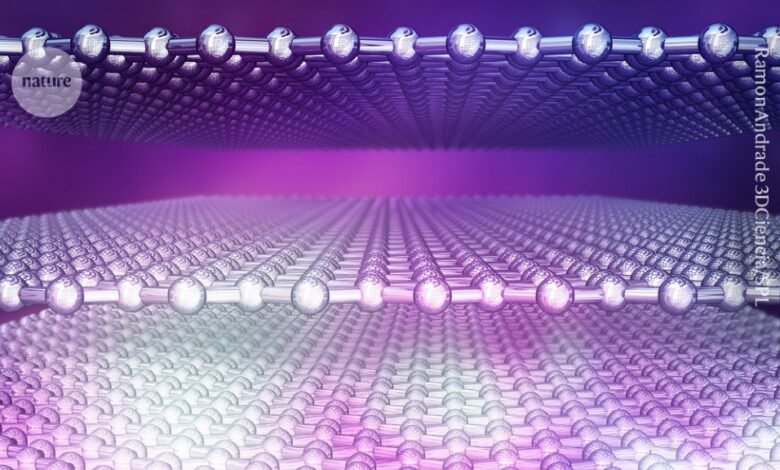
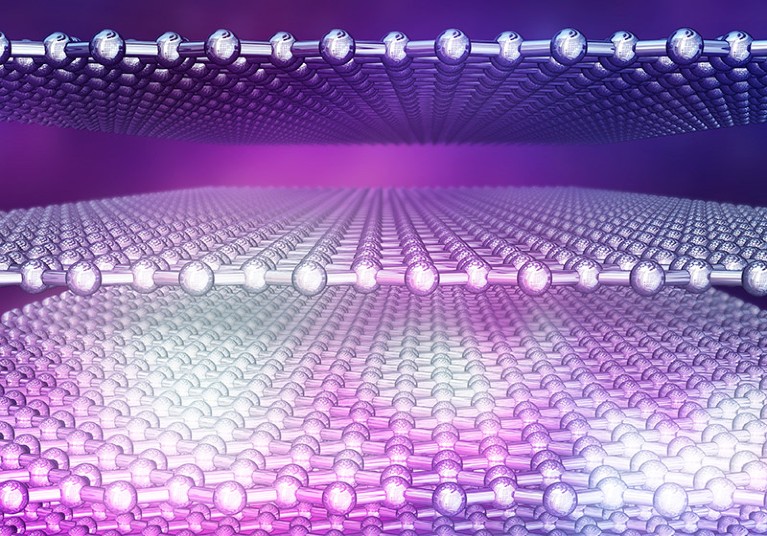
Electrons in stacked sheets of staggered graphene collectively act as though they have fractional charges at ultra-low temperatures.Credit: Ramon Andrade 3DCiencia/Science Photo Library
Minneapolis, Minnesota
Last May, a team led by physicists at the University of Washington in Seattle observed something peculiar. When the scientists ran an electrical current across two atom-thin sheets of molybdenum ditelluride (MoTe2), the electrons acted in concert, like particles with fractional charges. Resistance measurements showed that, rather than the usual charge of –1, the electrons behaved similar to particles with charges of –2/3 or –3/5, for instance. What was truly odd was that the electrons did this entirely because of the innate properties of the material, without any external magnetic field coaxing them. The researchers published the results a few months later, in August1.
Strange topological materials are popping up everywhere physicists look
That same month, this phenomenon, known as the fractional quantum anomalous Hall effect (FQAHE), was also observed in a completely different material. A team led by Long Ju, a condensed-matter physicist at the Massachusetts Institute of Technology (MIT) in Cambridge, saw the effect when they sandwiched five layers of graphene between sheets of boron nitride. They published their results in February this year2 — and physicists are still buzzing about it.
At the American Physical Society (APS) March Meeting, held in Minneapolis, Minnesota, from 3 to 8 March, Ju presented the team’s findings, which haven’t yet been replicated by other researchers. Attendees, including Raquel Queiroz, a theoretical physicist at Columbia University in New York City, said that they thought the results were convincing, but were scratching their heads over the discovery. “There is a lot we don’t understand,” Queiroz says. Figuring out the exact mechanism of the FQAHE in the layered graphene will be “a lot of work ahead of theorists”, she adds.
Although the FQAHE might have practical applications down the line — fractionally charged particles are a key requirement for a certain type of quantum computer — the findings are capturing physicists’ imagination because they are fundamentally new discoveries about how electrons behave.
“I don’t know anyone who’s not excited about this,” says Pablo Jarillo-Herrero, a condensed-matter physicist at MIT who was not involved with the studies. “I think the question is whether you’re so excited that you switch all your research and start working on it, or if you’re just very excited.”
Strange maths
Strange behaviour by electrons isn’t new.
In some materials, usually at temperatures near absolute zero, electrical resistance becomes quantized. Specifically it’s the material’s transverse resistance that does this. (An electrical current encounters opposition to its flow in both the same direction as the current — called longitudinal resistance — and in the perpendicular direction — what’s called transverse resistance.)
Quantized ‘steps’ in the transverse resistance occur at multiples of electron charge: 1, 2, 3 and so on. These plateaus are the result of a strange phenomenon: the electrons maintain the same transverse resistance even as charge density increases. That’s a little like vehicles on a highway moving at the same speed, even with more traffic. This is known as the quantum Hall effect.
In a different set of materials, with less disorder, the transverse resistance can even display plateaus at fractions of electron charge: 2/5, 3/7 and 4/9, for example. The plateaus take these values because the electrons collectively act like particles with fractional charges — hence the fractional quantum Hall effect (FQHE).
Key to both phenomena is a strong external magnetic field, which prevents electrons from crashing into each other and enables them to interact.
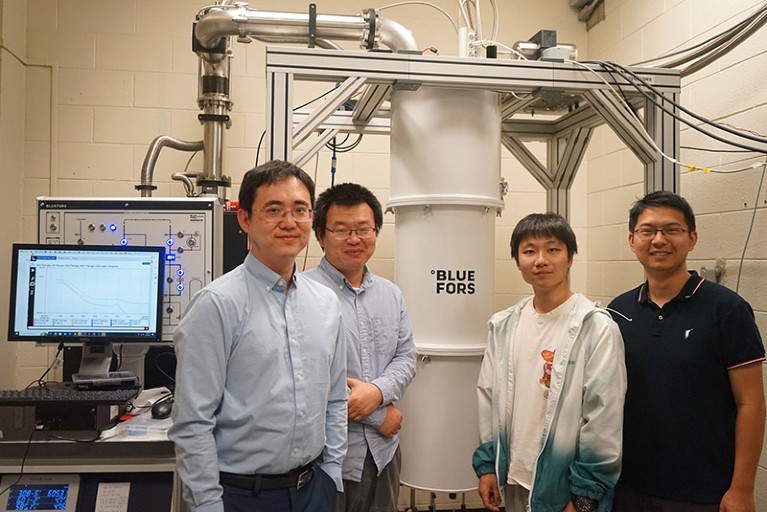
(Left to right) Long Ju, Zhengguang Lu, Yuxuan Yao and Tonghang Hang are all part of the team at MIT that demonstrated the FQAHE in layered graphene.Credit: Jixiang Yang
The FQHE, discovered in 1982, revealed the richness of electron behaviour. No longer could physicists think of electrons as single particles; in delicate quantum arrangements, the electrons could lose their individuality and act together to create fractionally charged particles. “I think people don’t appreciate how different [the fractional] is from the integer quantum Hall effect,” says Ashvin Vishwanath, a theoretical physicist at Harvard University in Cambridge. “It’s a new world.”
Over the next few decades, theoretical physicists came up with models to explain the FQHE and predict its effects. During their exploration, a tantalizing possibility appeared: perhaps a material could exhibit resistance plateaus without any external magnetic field. The effect, now dubbed the quantum anomalous Hall effect — ‘anomalous’, for the lack of a magnetic field — was finally observed in thin ferromagnetic films by a team at Tsinghua University in Beijing, in 20123.
Carbon copy
Roughly a decade later, the University of Washington team reported the FQAHE for the first time1, in a specially designed 2D material: two sheets of MoTe2 stacked on top of one another and offset by a twist.
This arrangement of MoTe2 is known as a moiré material. Originally used to refer to a patterned textile, the term has been appropriated by physicists to describe the patterns in 2D materials created from atom-thin lattices when they are stacked and then twisted, or staggered atop one another. The slight offset between atoms in different layers of the material shifts the hills and valleys of its electric potential. And it effectively acts like a powerful magnetic field, taking the place of the one needed in the quantum Hall effect and the FQHE.
Xiaodong Xu, a condensed-matter physicist at the University of Washington, talked about the MoTe2 discovery at the APS meeting. Theory hinted that the FQAHE would appear in the material at about a 1.4º twist angle. “We spent a year on it, and we didn’t see anything,” Xu told Nature.
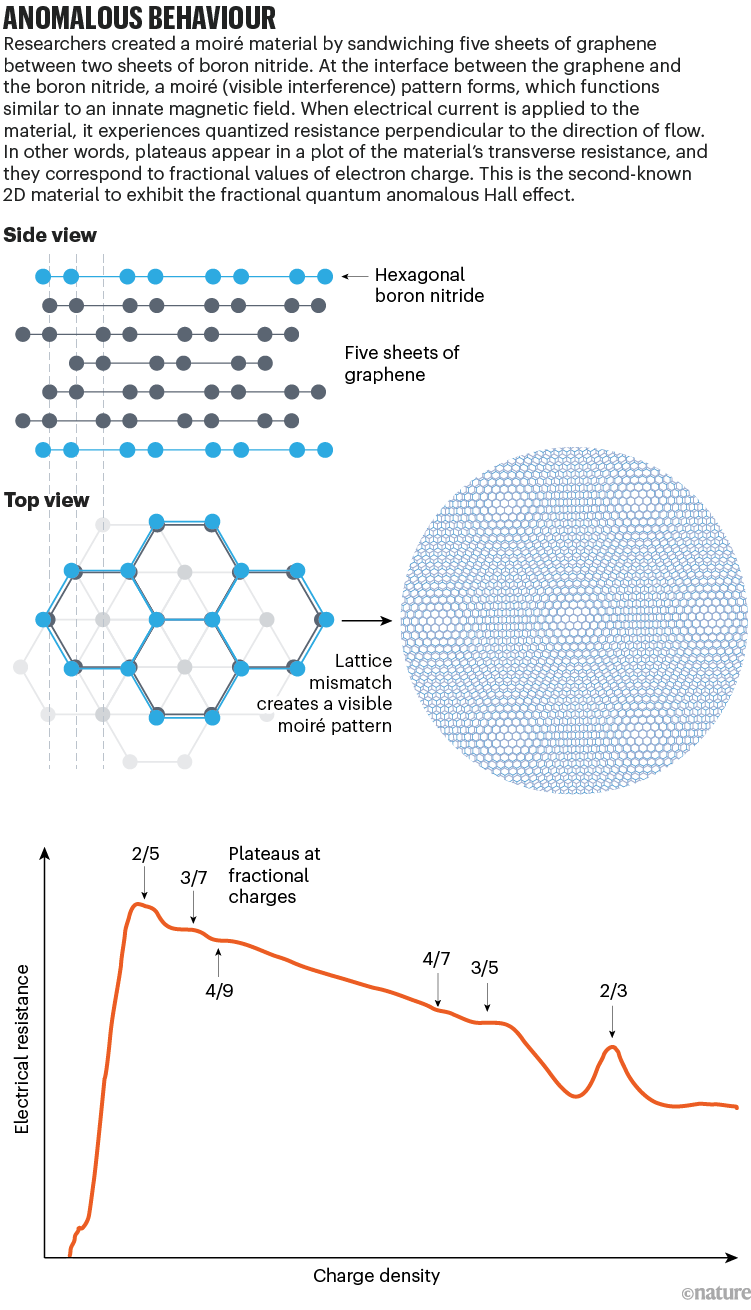
Source: Adapted from Ref. 2.
Then, the researchers tried a larger angle — a twist of about 4º. Immediately, they began seeing signs of the effect. Eventually, they measured the electrical resistance and spotted the signature plateaus of the FQAHE. Soon after, a team led by researchers at Shanghai Jiao Tong University in China replicated the results4.
Meanwhile at MIT, Ju was perfecting his technique, sandwiching graphene between layers of boron nitride. Similar to graphene, the sheets of boron nitride that Ju’s team used were a mesh of atoms linked together in a hexagonal pattern. Its lattice has a slightly different size than graphene; the mismatch creates a moiré pattern (see ‘Anomalous behaviour’).
Last month, Ju published a report2 about seeing the characteristic plateaus. “It is a really amazing result,” Xu says. “I’m very happy to see there’s a second system.” Since then, Ju says that he’s also seen the effect when using four and six layers of graphene.
Both moiré systems have their pros and cons. MoTe2 exhibited the effect at a few Kelvin, as opposed to 0.1 Kelvin for the layered graphene sandwich. (Low temperatures are required to minimize disorder in the systems.) But graphene is a cleaner and higher-quality material that is easier to measure. Experimentalists are now trying to replicate the results in graphene and find other materials that behave similarly.
Moiré than bargained for
Theorists are relatively comfortable with the MoTe2 results, for which the FQAHE was partly predicted. But Ju’s layered graphene moiré was a shock to the community, and researchers are still struggling to explain how the effect happens. “There’s no universal consensus on what the correct theory is,” Vishwanath says. “But they all agree that it’s not the standard mechanism.” Vishwanath and his colleagues posted a preprint proposing a theory that the moiré pattern might not be that important to the FQAHE5.
Welcome anyons! Physicists find best evidence yet for long-sought 2D structures
One reason to doubt the importance of the moiré is the location of the electrons in the material: most of the activity is in the topmost layer of graphene, far away from the moiré pattern between the graphene and boron nitride at the bottom of the sandwich that is supposed to most strongly influence the electrons. But B. Andrei Bernevig, a theoretical physicist at Princeton University in New Jersey, and a co-author of another preprint proposing a mechanism for the FQAHE in the layered graphene6, urges caution about theory-based calculations, because they rely on currently unverified assumptions. He says that the moiré pattern probably matters, but less than it does in MoTe2.
For theorists, the uncertainty is exciting. “There are people who would say that everything has been seen in the quantum Hall effect,” Vishwanath says. But these experiments, especially the one using the layered graphene moiré, show that there are still more mysteries to uncover.
Source link

